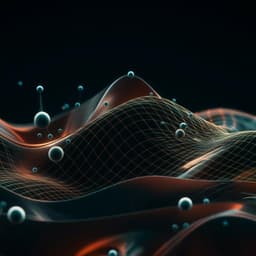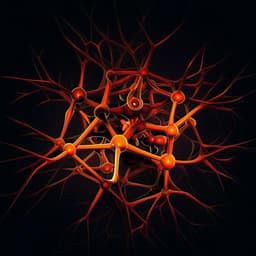
Medicine and Health
Months-long tracking of neuronal ensembles spanning multiple brain areas with Ultra-Flexible Tentacle Electrodes
T. B. Yasar, P. Gombkoto, et al.
Discover the groundbreaking research on Ultra-Flexible Tentacle Electrodes (UFTEs) by Tansel Baran Yasar and colleagues, showcasing a revolutionary high-density electrode array that allows for months-long monitoring of neurons in freely moving rodents, revealing the secrets of brain dynamics.
~3 min • Beginner • English
Introduction
The study addresses a key limitation in chronic electrophysiology: stiff and wide probes often damage tissue, provoke immune responses, and suffer from signal drift, hindering stable long-term single-unit recordings and tracking across brain areas. The authors propose Ultra-Flexible Tentacle Electrodes (UFTEs) that self-assemble into compact bundles for insertion and then decouple into subcellular-scale fibers to minimize footprint and motion relative to tissue. The research aims to (i) establish months-long, high-SNR, high-yield single-unit recordings from multiple superficial and deep regions in freely moving rodents; (ii) enable consistent tracking of individual neurons across months; and (iii) investigate the stability, tuning, and lifetimes of neuronal ensembles across hippocampus and cortical areas (RSC, mPFC) and their relation to hippocampal sharp-wave ripples (SWRs). By enabling distributed, angle-independent implantation, the authors seek to reveal inter-areal ensemble dynamics and test whether SWR-tuned ensembles differ in longevity from inter-areal ensembles.
Literature Review
Prior work shows chronic implants with stiff silicon or wire arrays can induce microglial activation, glial scarring, neuronal loss, and long-term SNR declines, limiting stable unit tracking (e.g., Utah arrays, silicon shanks). High-density rigid probes (e.g., Neuropixels 2.0) can track units up to 1–2 months using drift-correction but still face chronic tissue responses from stiff substrates. Flexible shanks and meshes reduce damage but face trade-offs between insertion stiffness, chemical tether dissolution kinetics, and depth/angle limitations. Recent ultraflexible approaches reduce footprint but often rely solely on biodegradable coatings, risking premature detachment or pull-out. On the systems side, hippocampal–cortical interactions during memory involve SWRs and coordinated activity across CA1, RSC, and mPFC, yet long-term, multi-area single-unit and ensemble tracking in freely moving animals remains scarce. This work builds on flexible/polymer electrode advances and ensemble detection techniques (PCA/ICA) to deliver months-long multi-area recordings and ensemble analyses.
Methodology
Device fabrication: UFTE arrays with 256 recording contacts were fabricated as Ti/Au metal traces sandwiched between polyimide layers (polyimide ~12 µm per layer), with each recording fiber mechanically decoupled (7 µm wide, 2.4 µm thick; cross-section 16.8 µm²; contact area 13×13 µm²). Contacts were coated with PEDOT:PSS via dry lift-off (≈450 nm total thickness) to reduce impedance (54 ± 16 kΩ at 1 kHz, mean ± s.d., n = 243). Broken channels by impedance screening were 1.6%. Arrays were organized into bundles (64 contacts per bundle; 4 bundles per 256-channel array). The longest fiber in each bundle ended in a 25 µm inner-diameter loop for mechanical tethering.
Assembly and implantation system: Bundles were coated with PEG and silk fibroin to hold fibers together during insertion. Crucially, the silk glue bound fibers to each other but not to the insertion shuttle. Mechanical coupling to a sharpened tungsten shuttle (50 µm diameter; etched tip) was achieved by inserting the shuttle through the loop of a single fiber, decoupling insertion mechanics from glue dissolution. After insertion, the shuttle was immediately retracted, and silk dissolved over hours, leaving independent ultraflexible fibers in tissue. This approach allows deep insertions (≥6.5 mm), arbitrary angles, and minimal lateral spread (~100 µm).
Electronics and packaging: UFTEs were soldered to custom 256-channel headstages (Intan-based), stackable up to 1024 channels. A titanium protective head cap (TitaniumHelmet) provided robust, biocompatible housing. A 512-channel wireless logger (data to SD card) was also tested.
Subjects and implants: Female Long Evans rats (n = 4, 21–95 weeks, 270–340 g) were implanted with four bundles targeting six regions: mPFC (IL, PrL, CG), RSC, dorsal hippocampus (dHPC), and intermediate hippocampus (iHPC). Thirteen bundles were implanted across rats. Insertion speed was 12.5 µm/s. Post-surgery recovery was 2–6 days.
Recordings: Freely moving rats were recorded twice weekly in a 50×50×50 cm cage; broadband data at 20 kHz, 16-bit, with 0.1 Hz hardware high-pass. Impedances were tracked at 1 kHz across months.
Spike sorting and unit tracking: For multi-session tracking, 20-min excerpts from each session were concatenated per rat and jointly spike-sorted (JRCLUST 4.0 pipeline): 300–5000 Hz band-pass, common average referencing, event detection (negative peaks; spatial/temporal merging within 60 µm/0.25 ms), PCA dimensionality reduction, Density Peak clustering, and manual curation. Quality metrics: SNR, ISI violation rate (<2 ms criterion), Mahalanobis distance to nearest neighbor; distributions for single- vs multi-units were significantly different (e.g., SNR single 14.6 ± 0.5 vs multi 6.8 ± 0.1; Wilcoxon p = 1.26×10^-4). Stability across sessions was validated by waveform similarity measures (e.g., standardized mean difference, Pearson correlation) for same-unit vs different-unit pairs.
SWR detection: LFP downsampled to 2 kHz; SWRs detected using Buzsáki lab’s NSS-based algorithm (findRipples) with thresholds and event merging; cross-validated with a CNN-based SWR detector. Events were temporally aligned to ripple-band power peaks with template cross-correlation (±5 ms constraint).
Ensemble detection: Spike trains were binned (25 ms) and z-scored. Significant ensembles were identified by PCA eigenvalues exceeding the Marchenko–Pastur threshold, then patterns extracted by FastICA. Ensemble membership was determined by Otsu thresholding on absolute IC weights. Instantaneous ensemble activation strength A(t) was computed using the member-weight matrix with diagonals zeroed, and ensembles were classified active when activation exceeded 2× s.d. over baseline.
Histology: After chronic experiments, brains were perfused and sectioned (100 µm). Immunostaining for IBA1 (microglia), GFAP (astrocytes), and Nissl/Neurotrace. Radial ROIs around implant sites assessed fluorescence intensity profiles normalized to 500 µm control regions. Confocal imaging and quantitative image analysis were performed.
Statistics: Normality assessed by Kolmogorov–Smirnov; Student’s t-test or Wilcoxon rank-sum as appropriate; significance reported for impedance changes, unit metrics, ensemble analyses. No a priori power calculation; blinding applied to sorting vs ensemble membership.
Key Findings
- UFTE design and implantation
- Subcellular-scale fibers (7 µm × 2.4 µm; 16.8 µm²) and PEDOT:PSS-coated contacts (13×13 µm²) achieved low impedance (54 ± 16 kΩ at 1 kHz; n = 243).
- Mechanical tethering via a single-fiber loop to a tungsten shuttle decoupled insertion from glue dissolution, enabling deep (≥6.5 mm), angle-independent insertions with minimal lateral spread (~100 µm).
- Immunostaining revealed no detectable chronic tissue damage several months post-implant.
- Recording quality and stability
- Mean single-unit SNRs were 1.5–3× higher than state-of-the-art flexible arrays; peak mean unit SNRs up to 89.
- Impedance magnitudes increased over the first month then stabilized (examples): Rat 1 medians 257.5 kΩ (n=184), 260.2 kΩ (n=182), 313.0 kΩ (n=185) on days 27, 61, 95; Rat 2 medians 329 kΩ (n=236), 450.5 kΩ (n=234), 540.5 kΩ (n=210) on days 24, 59, 90.
- Single-unit SNR (mean ± s.e.m.): week 1, 11.0 ± 0.6 (n=95); month 1, 15.3 ± 0.4 (n=377); month 3, 12.7 ± 0.3 (n=410).
- Yields per recording contact: cortical bundles 1.4 (week 1; 251 units), 0.80 (month 1; 289), 1.76 (month 2; 313), 1.50 (month 3; 267) across 178 contacts; hippocampal bundles 0.93 (week 1; 232), 0.97 (month 1; 241), 0.85 (months 2–3; 213), 0.80 (month 3; 200) across 249 contacts.
- Trackability: 19.1% of units trackable for 3 months; 39.8% >2 months; 66.5% >1 month; 90.3% >1 week (n=445 single units across two rats). Same neurons were tracked for up to at least 10 months (longest tested).
- Multi-area recordings and ensembles
- Simultaneous high-density recordings from mPFC (IL, PrL, CG), RSC, dHPC, and iHPC in freely moving rats captured laminar signals and diverse cell types (e.g., theta-modulated RSC neurons, head-direction cells).
- Detected 34 ensembles (Rat #1) and 45 (Rat #2) spanning hippocampal and cortical regions.
- Ensemble vs neuron lifetime: median ensemble lifetime 4 days vs neuron lifetime 24 days (n=79 ensembles); ensembles were significantly shorter-lived than neuron detectability (Wilcoxon p = 1.41×10^-10). Some ensembles disappeared for days–weeks despite all member neurons remaining detectable, then re-emerged.
- SWR tuning vs longevity: Ensembles with strong SWR activation had significantly shorter lifetimes than weakly SWR-tuned ensembles (Wilcoxon p = 0.0027). Median SWR activation strength: short-lived (≤18 days) 26.5 vs long-lived (≥18 days) 0.8. Ensembles with high SWR activation (≥2.9) had shorter lifetimes than low activation (<1.1) groups (p = 0.013). SWR-tuned ensembles were mostly hippocampal; inter-areal hippocampal–cortical ensembles had weak SWR tuning and unusually long lifetimes (months), occasionally inactive for weeks before re-emergence.
- System advances
- Developed a 512-channel wireless logger (local SD storage). TitaniumHelmet provided robust, reusable, biocompatible protection and modular stacking of 256-channel headstages.
Discussion
UFTEs combine ultra-flexibility, subcellular-scale footprint, and a hybrid mechanical–chemical insertion strategy to minimize chronic tissue responses and motion between electrode and tissue. This design yields superior single-unit SNRs, high unit yields, and stable long-term tracking versus stiff or wide flexible probes that can provoke gliosis and neuron loss. Unlike high-density rigid arrays that rely on spatial sampling and drift correction, UFTEs reduce drift at the source by minimizing relative motion, enabling months-long stable single-unit recordings across multiple deep and superficial regions with freely selectable contact allocation per area.
Functionally, UFTEs revealed distinct classes of neuronal ensembles across hippocampus and cortex: strongly SWR-tuned ensembles (mostly hippocampal) tended to be short-lived, whereas inter-areal hippocampal–cortical ensembles with weak SWR tuning could persist for months and even re-emerge after silent periods. These findings suggest that different ensemble classes support different aspects or timescales of memory processing. The authors hypothesize that long-lived, weakly SWR-tuned ensembles may involve deep CA1 pyramidal neurons with strong mPFC coupling, aligning with prior reports of layer-specific firing patterns and memory roles. The observation of months-long inter-areal ensembles challenges the view that only cortical ensembles maintain remote memories, highlighting a sustained hippocampal–cortical contribution.
Technically, the mechanically tethered insertion through a single-fiber loop allows strong glues and immediate shuttle retraction, enabling deep, angle-independent placements with minimal footprint. The approach scales with the square root of channel count, facilitating high-channel-count, distributed, minimally invasive recordings.
Conclusion
This work introduces UFTEs, a scalable, minimally invasive electrode technology that enables months-long, stable, high-SNR single-unit recordings and tracking across multiple deep and superficial brain regions in freely moving rodents. UFTEs allow simultaneous multi-area implantation at arbitrary angles, deliver high unit yields, and support ensemble analyses that uncovered two classes of ensembles with distinct SWR tuning and longevity, including months-long inter-areal hippocampal–cortical ensembles.
UFTEs have broad implications for systems neuroscience and neurotechnology: enabling studies of long-term memory dynamics across distributed networks, improving chronic stability for brain–machine interfaces, and potentially minimizing tissue damage in clinical implants. A 3D human version is under development for studying epileptogenic tissue. Future work should extend to larger animals/humans with stiffer shuttles as needed, investigate causal roles of long-lived inter-areal ensembles in behavior and memory, and establish standardized, scalable methods for multi-session unit and ensemble tracking.
Limitations
- Species and sample size: Demonstrations were in rats (n=4) and mice (sham/acute), limiting generalizability; no a priori power analysis.
- Duration: Neuron tracking was shown up to 10 months; ensemble analyses spanned ~3.5 months—longer-term behavior remains to be characterized.
- Shuttle mechanics: 50 µm tungsten shuttles may be insufficient for very deep targets in larger animals or humans; stiffer/larger shuttles or different materials may be required.
- Dynamic unit composition: Some units disappeared/reappeared across sessions or new units emerged on the same contact, potentially due to firing-rate changes, micro-movements, or cell turnover.
- Recording impedance drift: Impedances increased over the first month before stabilizing.
- Methodological: Spike sorting/ensemble analyses were not randomized; blinding applied to sorting vs ensemble membership. There are no widely accepted standards for cross-session unit tracking; the method used concatenated multi-session sorting plus similarity checks.
- Wireless logger: 512-channel wireless logger saved to SD without transmission; fully wireless streaming performance not assessed here.
Related Publications
Explore these studies to deepen your understanding of the subject.







